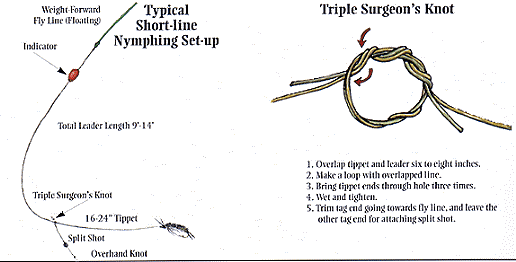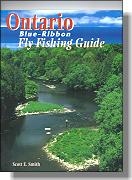Blue Ribbon Fly Fishing in Ontario, Part 3
Coastal Treasures - Techniques
By Scott E. Smith
Excerpt from: Ontario, Blue-Ribbon Fly Fishing Guide
Published by: Frank Amato Publications, Inc.
P.O. Box 82112, Portland Oregon 97282 Phone: 503-653-8108,
email Frank Amato Publications
Although the basic principals of fly fishing are in essence
applicable to fishing Ontario's coastal streams, one need to be
especially proficient with two basic fly-fishing techniques:
Short-line nymphing and the wet-fly swing.
Many of Ontario's Great lakes tributaries are freestone spate rivers;
almost exclusively in the case of the Lake Superior drainage. All
migratory fish runs are triggered or influenced to some extent by
freshets of runoff; either from heavy rains or snow-melt. Subsequently,
much of the fly fishing for migratory salmonids requires skills and
techniques appropriate for plying pocket water, plunge pools and
other holding water. The method of presenting a fly on a dead-drift with
as little drag as possible at the bottom of the water column where
salmoniods are located in their holding lies. The basic eqwuipment
required for this technique includes: A long (nine-to ten-foot) fly
rod, usually in the seven- to nine-weight class; a floating line; and
a long leader, anywhere from nine to fifteen feet in length. Dependent
on the situation, the use of a foam or cork indicator is also effective.
It is not critical that the leader be of the tapered variety - as
required for dry-fly fishing - but often the leader is constructed
starting with heavy butt material and then stepped down to a suitably
strong and abrasion-resistant tippet. Generally split shot is added
to the leader to get the system down to the bottom of the water column,
although in some situations a weighted nymph will suffice. Attaching
split shot to a short dropper line will result in fewer lost flies. A
good way to tie in a dropper line is to use a triple surgeon's knot
between the leader and the tippet, leaving the tag end of the leader
intact. An overhand knot placed at the end of this two-inch dropper
will prevent the split shot from sliding off while casting. [See the
illustration below.]

The presentation is made by casting upstream of your target holding
lie, then by implementing various mending techniques the system is allowed
to dead drift with the current, as any nymph or natural egg would.
Although the absolute best way to present the fly to a holding fish is
to cast from a position slightly upstream and accross from the holding
lie, presentations can be made from directly across or below the target.
The tuck-cast is an absolute must for this type of fishing. This
specialized cast allows the fly line and leader to land upstream of the
fly which enables it to sink drag-free. The tuck cast is implemented by
arresting the forward cast just as the loop is beginning to straighten.
An abrupt backwards and upwards snap of the wrist is used to accomplish
this. Tuck casts are particularly effective when using an indicator.
A common angler error when fishing the short-line nymph technique
is to attempt to fish water too far away - or across current - from
the angler's position. In such cases the effect of current (drag)
is greatly accentuated, often resulting in the fly scooting far
above any holding fish. It is far better to wade closer to the holding
lie, than to attempt long casts with this technique.
When short-line numphing, think of the indicator - or in the absence
of, the fly line - as a dry fly that you are attempting to fish drag-free;
this will assist you in ensuring the fly is also drifting drag-free.
Your indicator or fly line should be drifting slightly slower than the
surface water: this is a tell-tale sign that indicated the fly is
near the bottom of the water column, which is always slower in
current speed.
 Next time: Wet-Fly Swing! ~ Scott E. Smith
Our Man In Canada Archives
Next time: Wet-Fly Swing! ~ Scott E. Smith
Our Man In Canada Archives
|



